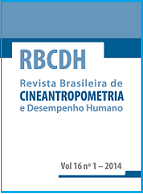Efeito agudo da imagética no desempenho de lances livres e percepção de autoeficácia em atletas
DOI:
https://doi.org/10.1590/1980-0037.2014v16n1p47Resumen
O esporte cada vez mais diferencia vencedores e perdedores por mínimos detalhes. No basquetebol um fator diferenciador é o lance livre. Sessões de imagética motora (IMA) vêm sendo estudada como um ergogênico sobre o desempenho de lance livre, porém, pouco se estuda o seu efeito agudo, principalmente, em atletas. O objetivo desse estudo foi verificar o efeito de uma sessão prévia de treinamento mental sobre o desempenho no lance livre e na percepção de autoeficácia de jovens atletas. Participaram do estudo 11 atletas juvenis da Federação Paulista de Basquete. Na condição IMA, foram submetidos a 1 minuto de vídeo + 3 minutos de imagética, seguidos de 10 lances livres, e no controle, 4 minutos de repouso seguidos de 10 lances livres. O questionário de autoeficácia foi preenchido antes e após a intervenção. Para análise estatística, foram utilizados os testes U de Mann-Withney, Wilcoxon e o Smallest Wothwhille Change (SWC). Não foi encontrada diferença entre a mediana dos grupos, porém, o SWC apontou uma possibilidade de 84% de efeito benéfico do treinamento mental sobre o desempenho para até 2 lances livres. Concluiu-se que a imagética motora prévia tem 84% de chance de causar um efeito benéfico sobre o desempenho de lance livre em até 2 arremessos.
Descargas
Publicado
Número
Sección
Licencia

Direitos Autorais para artigos publicados nesta revista são do autor, com direitos de primeira publicação para a revista. Em virtude da aparecerem nesta revista de acesso público, os artigos são de uso gratuito, com atribuições próprias, em aplicações educacionais e não-comerciais, desde que seja dada a atribuição. Esta obra foi licenciada com uma Licença Creative Commons Atribuição 4.0 Internacional - CC BY


